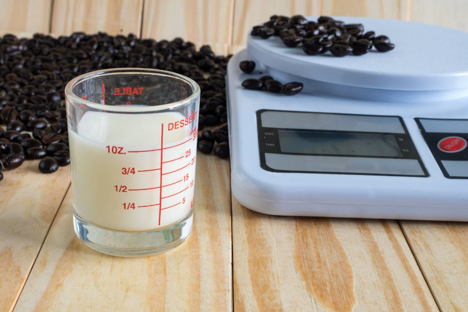When it comes to listed ingredients in a recipe you can either use a measure of weight or a measure of volume. Weight refers to the actual weight of and ingredients as read by a scale and volume is the amount of space an ingredient takes up according to defined dimensions. In this case the dimensions usually used in cooking are gallons, quarts, pints, cups, tablespoons, and teaspoons. These volumetric measures are not completely accurate and can often lead cooks to make mistakes; therefore when it comes to exceptional cooking, precision is everything. The way ingredients are measured — by weight or by volume — can make or break a dish, especially in settings where consistency is key. Whether you’re preparing delicate pastries or a hearty stew, understanding when and why to use weight over volume (or vice versa) is crucial to mastering your craft as a chef.
Why you need a digital scale: Measuring ingredients by weight, using a scale, is the gold standard for professional chefs. Here’s why:
Accuracy: Ingredients like flour, sugar, and butter can vary in volume depending on how they are packed, settled, or even scooped. A cup of flour could weigh differently from day to day based on humidity, how it’s packed, or the chef’s hand. Weighing removes all these variables, ensuring that 8 ounces of flour today will be the same as 8 ounces tomorrow. This is especially crucial in baking, where precision is the backbone of success. An accurate understanding of weight vs. volume will help you achieve this precision.
Consistency Across Batches: In a restaurant setting, dishes need to taste the same every time they’re served. If you’re running a bakery or a patisserie, a slight variance in the amount of flour, sugar, or butter can throw off the entire recipe. Using weight ensures that each batch, from the first to the hundredth, is exactly the same. Additionally, volume measures are not consistent between manufactures and countries. I remember getting a one cup measure with my Japanese rice cooker and when I checked it against my American made counterpart it was 2 ounces (25 percent) smaller.
Efficiency: Professional kitchens often deal with large quantities of ingredients. Using a scale can streamline the process of measuring out these quantities, particularly for bulk items. It’s easier to weigh 4 pounds of flour than it is to scoop out 8 cups and hope they’re all perfectly level. Weighing versus using volume measurements can be a real time saver in such cases.
The only case for volume: Convience and speed
Measuring by volume (using cups, teaspoons, and tablespoons) is often faster and more convenient, especially when dealing with liquids or small amounts of dry ingredients. Here’s where it works best:
Rice and Beans: Measuring rice and /or beans by volume (using cups or scoops) is a common exception and appropriate method in both home and professional kitchens, especially when time is of the essence. Here’s why it works: Scooping a cup of rice is much quicker than pulling out a scale, and for many traditional dishes, such as pilafs or cooked rice in a rice cooker, the volume method is often built into the recipe. For instance, a 1:2 ratio (1 cup of rice to 2 cups of water) is a simple and reliable way to ensure well-cooked rice.
Liquids: Measuring liquids like water, milk, or stock, by volume is standard practice. It’s quick, and for most recipes, a slight variation in liquid measurements won’t make a huge difference in the outcome. In contrast, weight measurements for liquids are typically unnecessary.
Herbs and Spices: For small amounts of ingredients like herbs, spices, or flavorings, volume measurements are often sufficient. A teaspoon of oregano or a tablespoon of salt is quick and efficient to measure by volume without requiring the precision of a scale.
Tenzo’s Tip: When it comes to recipes provided on this website all ingredients over ½ ounce are listed as weight measurements (note the volume exception above) and should be scaled for accuracy. For ingredients that are smaller than ½ ounce I have listed them in tablespoons and teaspoons. For these smaller measurements, the lack of efficacy of volume measurements isn’t enough of a factor to significantly change the final outcome. Understanding weight vs. volume will help you follow these guidelines accurately.
The conclusion: Using the right tool for the job in the right way.
In a successful kitchens, both weight and volume measurements have their place. Understanding when to use each can make a significant difference in the quality and consistency of your dishes. For dry ingredients, in the vast majority of circumstances, weighing is the way to go. For liquids and small quantities, volume measurements offer speed and convenience. This balance of weight vs. volume will improve your cooking.
